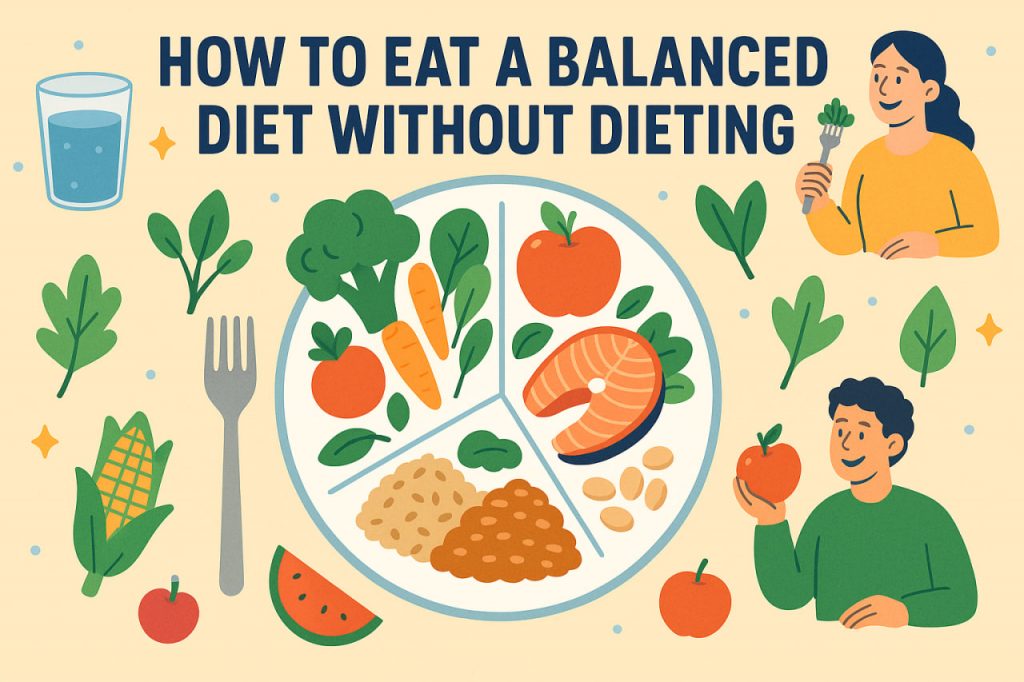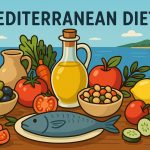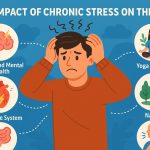Eating well doesn’t have to mean counting every calorie or cutting out your favorite foods. A balanced diet without strict dieting is about creating long-term, sustainable habits that nourish your body, support your energy, and protect your health. The goal is not perfection—but consistency, flexibility, and understanding your body’s needs.
What Is a Balanced Diet?
A balanced diet provides your body with all the essential nutrients it needs to function properly—carbohydrates, proteins, fats, vitamins, minerals, and water. It emphasizes variety, moderation, and natural, minimally processed foods.
Here’s how a healthy plate typically looks:
- ½ vegetables and fruits (fresh or cooked)
- ¼ whole grains (like brown rice, oats, quinoa)
- ¼ protein (fish, eggs, legumes, lean meat)
- Plus a small portion of healthy fats and plenty of water
Core Principles of Eating Without Dieting
- Eat Real Food, Not Rules
Focus on foods that are as close to their natural form as possible. Think fresh vegetables, fruits, whole grains, nuts, seeds, and lean proteins. - Follow the 80/20 Rule
Eat nutritious meals 80% of the time, and enjoy treats 20% of the time without guilt. This encourages balance without obsession. - Listen to Your Body
Eat when you’re hungry, stop when you’re satisfied. Learn to recognize true hunger versus emotional eating. - Don’t Demonize Any Food Group
Carbs, fats, and proteins all play important roles. Elimination can lead to deficiencies and cravings. - Add, Don’t Subtract
Instead of removing food, try adding more fiber, more color, and more variety to meals. - Plan Smart, Not Perfect
A bit of weekly planning helps you avoid last-minute unhealthy choices while still allowing flexibility.
Healthy Eating Habits to Practice
- Include protein in every meal—it helps you stay full longer.
- Eat fiber-rich foods like vegetables, beans, and whole grains.
- Stay hydrated—sometimes thirst is mistaken for hunger.
- Don’t skip meals, especially breakfast—it can lead to overeating later.
- Cook more often at home, where you control the ingredients and portions.
Sample One-Day Balanced Menu
Breakfast:
Oatmeal with banana, chia seeds, and almond butter
Snack:
Greek yogurt with berries
Lunch:
Grilled chicken with quinoa, roasted vegetables, and olive oil dressing
Snack:
Apple with a handful of walnuts
Dinner:
Lentil stew with leafy greens and whole grain bread
Drink:
Water throughout the day, herbal tea in the evening
Mental Health and Food Relationship
Balanced eating also means developing a positive relationship with food. Avoid labeling food as “good” or “bad.” All foods can fit into a healthy lifestyle when consumed mindfully.
Conclusion
You don’t need a strict diet to be healthy. Eating balanced is about variety, moderation, and enjoying your meals. When you shift from dieting to nourishing, you’ll build a more sustainable, happier relationship with food—and with your body.
Glossary
- Macronutrients: The main nutrients your body needs in large amounts—carbs, proteins, and fats.
- Fiber: A plant-based carbohydrate that aids digestion and keeps you full.
- Mindful Eating: Being aware and present while eating, paying attention to hunger and fullness.
- Whole Foods: Foods that are minimally processed and rich in nutrients.


